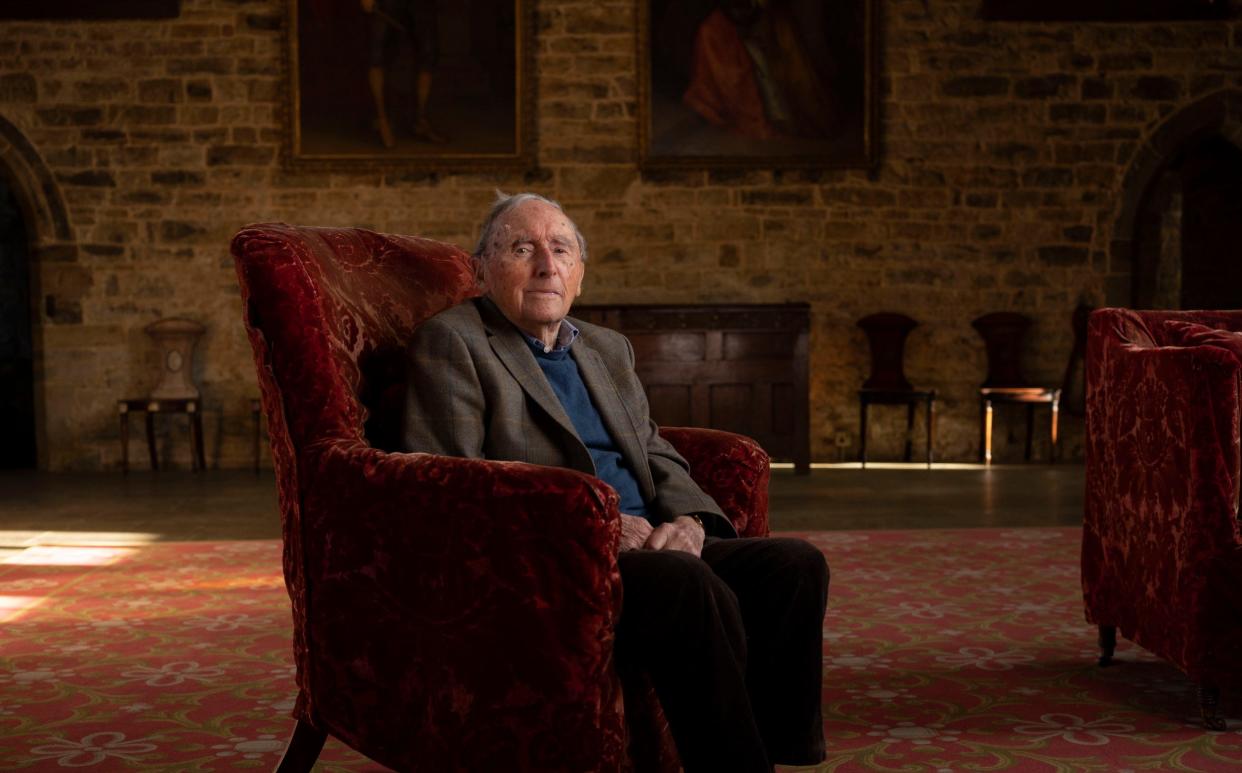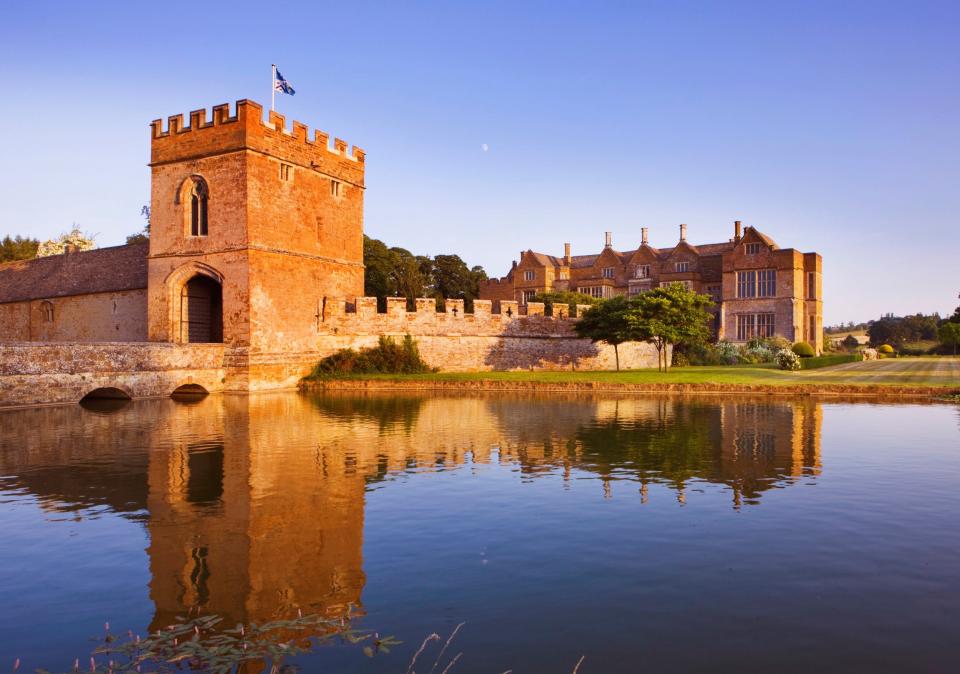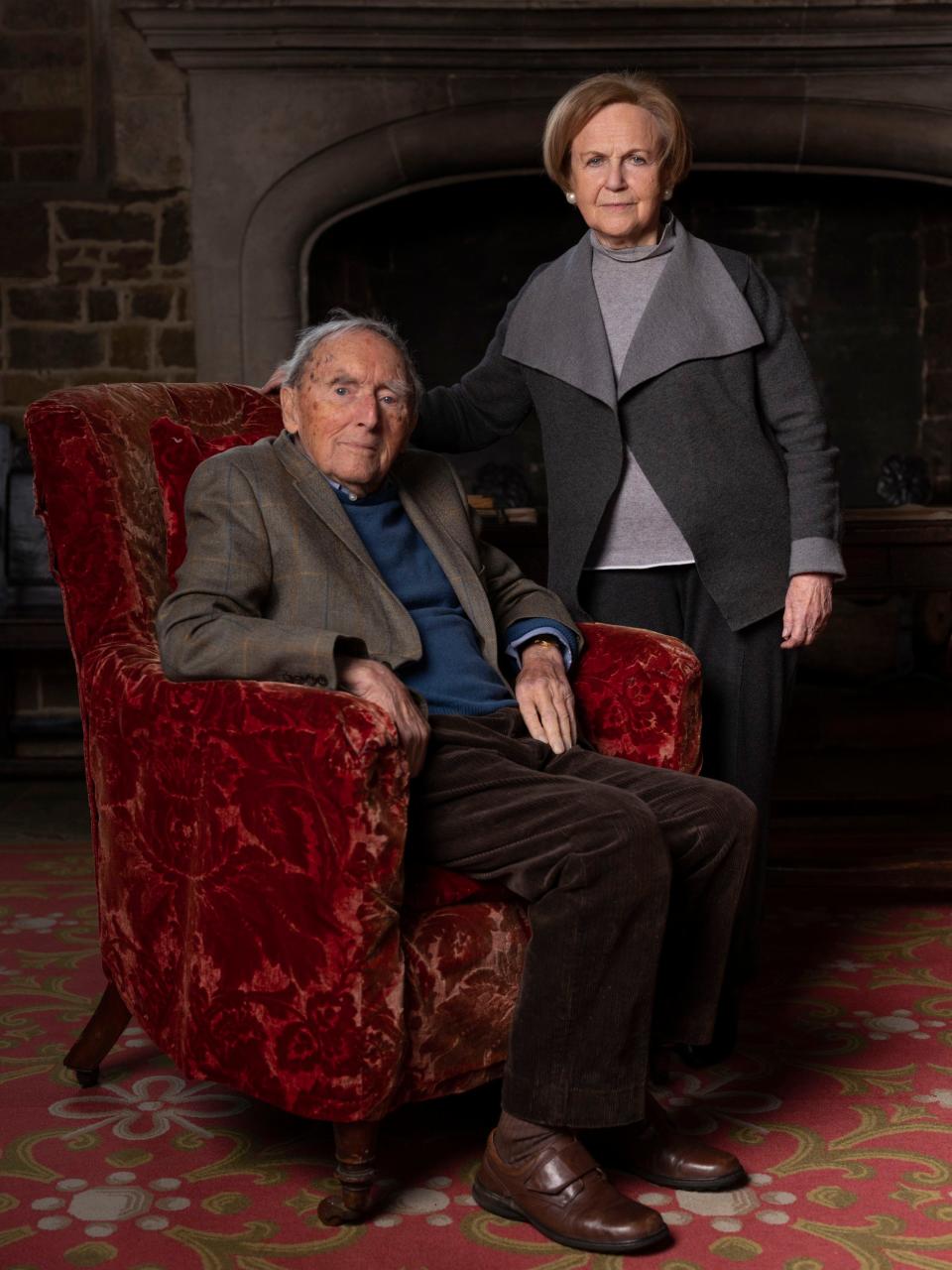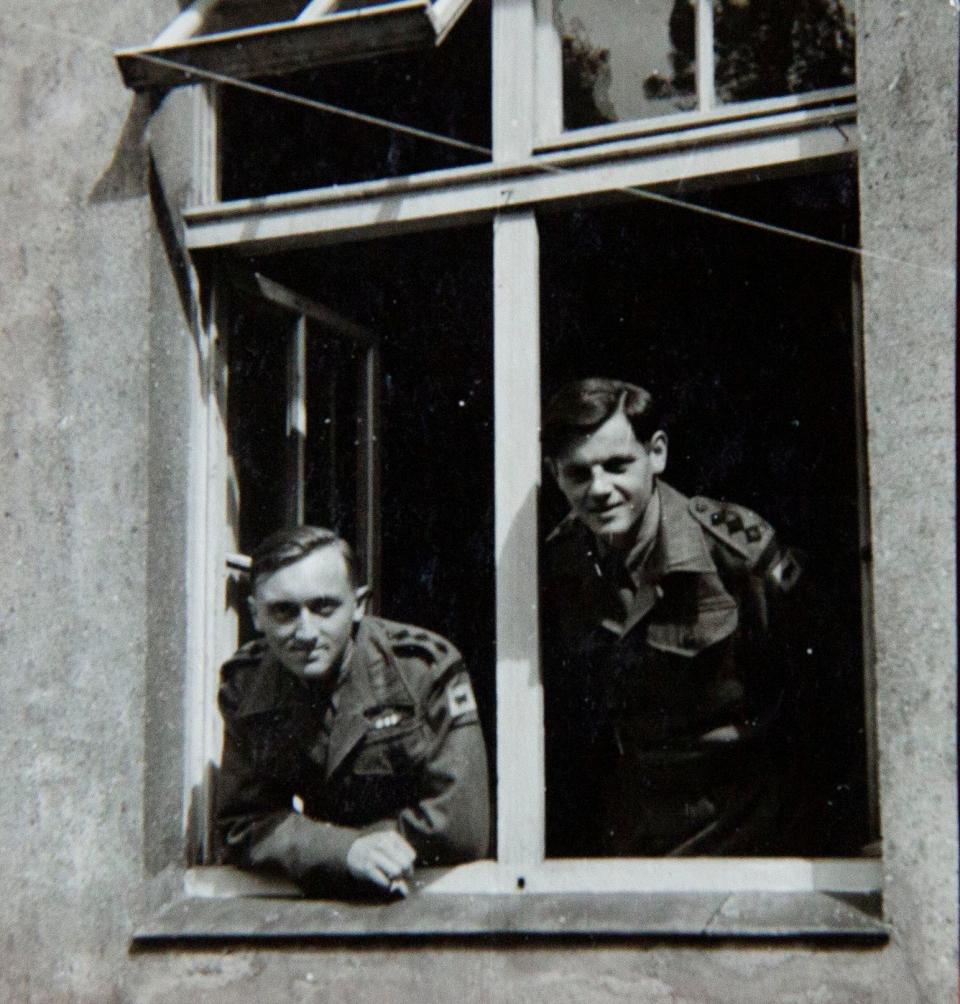Lord Saye and Sele, custodian of Broughton Castle and one of the first soldiers to enter Belsen – obituary

- Oops!Something went wrong.Please try again later.
- Oops!Something went wrong.Please try again later.
- Oops!Something went wrong.Please try again later.
- Oops!Something went wrong.Please try again later.
Nathaniel Fiennes, Lord Saye and Sele, who has died aged 103, was a land agent who devoted much of his energy to restoring and maintaining Broughton Castle, the beautiful moated medieval mansion near Banbury, Oxfordshire, which had been in his family since 1377.
Known as Nat to family and friends, Lord Saye was 21st in a line that started in 1447. The first Lord Saye fought at Agincourt and was Treasurer of England before being beheaded in Jack Cade’s Rebellion of 1450 (“He can speak French; and therefore he is a traitor,” Shakespeare’s rebel explains in Henry VI Part 2).
Another ancestor, the 8th Lord Saye, was a key figure in the Parliamentarian opposition to King Charles I along with John Hampden and John Pym. Saye raised troops to fight against the king at the inconclusive Battle of Edgehill in 1642, and in retaliation Royalist troops occupied Broughton Castle from October 1642 to 1644. Charles I had nicknamed him “Old Subtlety” in the years preceding the Civil War. After it, Lord Saye promoted a middle way and opposed the King’s execution. He was pardoned by Charles II and died in 1662.
The wider family now includes the actor brothers Ralph (The English Patient) and Joseph Fiennes (Shakespeare in Love) and the explorer Sir Ranulph Fiennes.
Broughton Castle became the family seat in 1448, when William Fiennes, 2nd Baron Saye and Sele, married a descendant of William of Wykeham, Bishop of Winchester and founder of Winchester College and New College, Oxford, who had bought the house in 1377.
In the 1550s, under Elizabeth I, the family modernised Wykeham’s manor house, built in the early 1300s, after which, apart from the addition of plaster ceilings in the 18th century, it remained almost unchanged. Broughton Castle is therefore a prime example of a late medieval mansion, enhanced by Tudor architects but unspoiled by any later alterations. James Lees-Milne described it as “the most romantic house imaginable. English to the core.”

The Fiennes family (which extended the name to Twisleton-Wykeham-Fiennes in the mid-19th century) were well off but never hugely wealthy. Much of what they did have in land and money was dissipated by the colourful 15th Baron (known as “The Regency Buck”) who by 1847 had gambled and drunk his way through most of the family fortune, even selling the swans from the Castle moat. Most of the rest was lost by the horse-racing extravagances of the 17th Baron in the late 19th century.
Lord Saye recalled that when his father inherited the house in 1948 “there was water coming through the roof and no decoration had taken place for 50 years. And we had no money.”
His father began the process of setting things right, with a 100 per cent grant from the then Historic Buildings Council, renewing the castle’s stone-tiled roof in the 1950s and opening the castle to the public to help pay the bills. After Lord Saye inherited the Castle in 1968 with a 1,800-acre estate and just £3,000, he and his wife Mariette carried out extensive interior redecoration and refurbishment.
Being a qualified chartered surveyor he understood the value of preventive maintenance, and in the early 1980s commissioned a £1 million, 12-year programme of work for a complete restoration of the Castle’s stonework and fabric. The stone had begun to crumble, the intricate leadwork in the windows had wasted, and the deathwatch beetle was chomping its way through the beams.
Though they were given a 40 per cent grant for the work by English Heritage, the family needed to raise more than £600,000 itself. “It was a real sink-or-swim time,” Lord Saye recalled.
Refusing to admit defeat, he developed the estate’s arable farming, boosted tourism to 15,000-20,000 visitors a year and rented out the castle to film companies. Broughton Castle’s medieval Great Hall, Tudor “Oak Room” and walled garden had starring roles in such films as Shakespeare in Love, Three Men and a Little Lady and The Madness of King George. “We’ve just had Gwyneth Paltrow here,” Lord Saye told an interviewer in 1997. “I gather she’s quite a big star.”

Lord Saye was realistic about the place of the aristocracy in the modern world. He did not attend the House of Lords, needing a full-time job to help with Broughton’s costs, and anyway believing it was right to abolish the voting rights of hereditary peers. He was often mistaken for the gardener, and was not too proud to turn himself into the car-park attendant on busy days, still going out in a hi-vis vest in his early 90s.
“One’s got to be prepared to live in a modest way,” he observed. “It’s no good thinking you’ve got to have a Bentley and a butler - that’ll break you.”
But he had no doubts about the vital importance of the hereditary principle in preserving Britain’s architectural heritage for the public benefit. In 1988, when the Environment Secretary Nicholas Ridley argued that if hereditary owners could not afford to maintain their stately piles they should sell out to those who could, he disagreed strongly, suggesting that the family link to a property was the most cost-effective way of preserving the fabric and “soul” of a place.

He was driven by a sense of stewardship, believing that Broughton was not just a family home but a national treasure, and that it was his task to look after it on behalf of future generations. Passionate about trees, he planted thousands in woods and along hedges, mindful of the landscape’s appearance not just next week but in a hundred years.
With the early input of the American garden designer Lanning Roper, he and Mariette created a celebrated garden at Broughton, informed by Gertrude Jekyll’s idea that “the garden should curtsey to the house”. In Simon Jenkins’s England’s 1000 Best Houses (2003), Broughton is one of only 20 houses in the country awarded the maximum five stars.
He was born Nathaniel Thomas Allen Twisleton-Wykeham-Fiennes on September 22 1920, the eldest son of Ivo Murray Twisleton-Wykeham-Fiennes. His mother, Hersey, was the daughter of Sir Thomas Butler, Yeoman Usher of the Black Rod. Nat was born in his grandfather’s grace-and-favour apartment in the Victoria Tower of the House of Lords, making him – perhaps uniquely – a Lord born in the Lords. In 1965, in a move characteristic of his discomfort with showiness and excess, Nat would relinquish the names Twisleton-Wykeham by deed poll.

Despite the family connection with Winchester College, Nat was educated at Eton, before following family tradition and studying at New College, Oxford. At Eton he started a promising cricket career, captaining the Eton XI and the Public Schools XI in 1939. Despite scoring 157 not out for Oxfordshire against a British Empire XI (“rank long-hops all afternoon”) his career was cut short by the War.
He signed up on September 3 1939 for the Oxfordshire & Bucks Light Infantry before being sent home to await further instructions, having been told he was too young.
In 1940 he joined the Royal Warwickshire Regiment as a private: his duties included defending the roof of Oxford’s Natural History Museum from fires caused by bombing. After Officer Training he joined the 8th Battalion of the Rifle Brigade and served with them as Adjutant from D-Day+6 in the battles around Caen, through the march across western Europe, and ending up in May 1945 in Schleswig Holstein, where he was appointed Military Commander on the North Frisian island of Sylt.
He was twice Mentioned in Despatches, but was reticent about his record until his nineties, when he began speaking publicly about his time in action, including the days in April 1945 when the 8th Rifle Brigade relieved the camp at Bergen-Belsen.

With two fellow officers, and despite the many signs warning of typhus, he entered the camp shortly after it was discovered. He would remember rows of people lying in the huts, and how hard it was to know who was dead and who was alive. “It was a sight you wouldn’t have believed possible to see,” he recalled. “And all I have to say is that if anyone ever denies the Holocaust, I’m very glad to stand up and tell them that I saw Belsen.”
In the aftermath of the war he was posted to Palestine with the Army Intelligence Corps before retiring from the Army in 1949.
He then trained as a chartered surveyor, worked for a time with John D Wood, was appointed land agent for Trinity College, Oxford, and founded a chartered surveyors’ practice with his friend George Laws, called Laws and Fiennes.
He acted as land agent for several Oxford colleges and a number of estates across the south of England, including Winchester College, Ditchley Park and the Penn estate in Buckinghamshire.
He was a trustee of the Ernest Cook Trust, which makes educational grants based on income from its rural estates, from 1959 until 1995, serving as chairman from 1964 until 1990. He served on the Estates Committee of the National Trust. He was a Fellow of Winchester College from 1967 to 1983, a regional director within Lloyds Bank from 1983 to 1990, and a Deputy Lieutenant of Oxfordshire from 1979.
He was actively involved with many local societies including the Banbury Rotary Club, the Banbury Lions Club, and the Banbury Historical Society, of which he was president for 50 years. He was an honorary vice-oresident of Epilepsy Action and a Patron of the Katharine House Hospice.
He continued to play cricket into the 1970s, a classically elegant batsman and wicketkeeper for the I Zingari and the Green Jackets, whose ground at St Cross near Winchester he thought of with special fondness.
Devoted to the arts, he relished Broughton’s nearness to the Royal Shakespeare Theatre in Stratford-upon-Avon, and listened to as many Proms as he could, with a special love for Beethoven and Mahler symphonies. He was a passionate reader, especially of 19th-century English and Russian novels, especially those by Trollope. He was immensely proud of his garden, and was in his element walking the borders with Mariette, pointing out favourite roses with his walking stick.
Lord Saye inherited the title on his father’s death in 1968. In 1958 he married Mariette, the daughter of Major-General Sir (Arthur) Guy Salisbury-Jones, GCVO, CMG, CBE, MC, with whom he had a daughter and four sons, of whom the youngest is the writer William Fiennes.
Lord Saye experienced great tragedy in his personal life. In The Music Room, published in 2009, William Fiennes recalled the shadows cast over family life by the death in 1968 of his parents’ third son, Thomas, aged nearly three, and the increasingly wayward behaviour of his eldest brother, Richard.
From the age of two Richard had suffered from epilepsy; brain damage sustained during repeated seizures meant that, though often happy and delightful, he could also be aggressive and sometimes violent.
Lord and Lady Saye showed saintly patience with their son and loved him unconditionally. But one image in The Music Room gives a sense of the burden they carried. After Richard, in a fury, had driven a metal bar through two windows, William recalled chancing upon his father outside, his head down and his palm pressed against a buttress. “I asked him what he was doing,” William wrote. “He said he was asking the house for some of its strength.”
In the 1990s Richard moved to live at an epilepsy centre in Cheshire but would often stay with his parents at weekends. It was during one of these visits, in 2001, that he died during an epileptic seizure aged 41.
Lord Saye and Sele is survived by his wife, his daughter, the artist Susannah Fiennes, and two sons, of whom the elder, Martin, born in 1961, inherits the title and the castle.
Lord Saye and Sele, born September 22 1920, died January 20 2024

